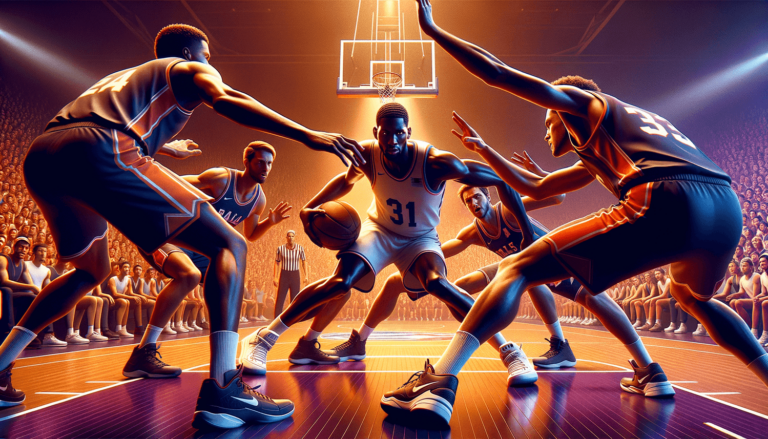
Three-Second Defensive Violation in Basketball
Written by: Basketball Universe
Last updated:

Hold onto your sneakers, basketball enthusiasts, because today we’re diving into the nitty-gritty of one of the most crucial aspects of the game: the three-second defensive violation! It’s a lesser-known rule, tucked away in the backcourt of basketball knowledge, but essential for everyone trying to master this beautiful sport. So, whether you’re a newcomer or a seasoned pro, grab your whistles and clipboards as we explore, dissect, and unwrap the intriguing concept behind the three-second defensive violation in basketball. Let’s get into it!
Three-Second Defensive Violation in Basketball
The three-second defensive violation in basketball occurs when a defensive player stays in the key (also known as the free-throw lane or the restricted area) for more than three consecutive seconds without closely guarding an opponent. This rule aims to prevent defensive players from camping the key, which can give them an unfair advantage in terms of shot blocking and rebounding. If the violation is called, the offensive team is awarded a technical free throw, and they retain possession of the ball.
Getting to Know the Key
Before we dive deeper into the three-second defensive violation, let’s get acquainted with the key. The key is a rectangular area painted on the basketball court that extends from the end line (baseline) to the free-throw line and is often marked with a free-throw circle. It is also known as the free-throw lane, the paint, or the restricted area. The key is a critical part of the basketball court as most of the action and strategic plays occur within or around it, and it greatly impacts the flow of the game.
Understanding the Three-Second Defensive Violation Rule
What’s the rule about?
The basketball rules state that the three-second defensive violation occurs when a defensive player spends more than three consecutive seconds inside the key without closely guarding an offensive player. This rule aims to prevent defenders from lingering in the key, stifling scoring opportunities for the offense, and gaining an unfair advantage in shot blocking and rebounding. The three-second count restarts whenever the player steps out of the key or begins closely guarding an opponent.
What happens when the rule is violated?
When a three-second defensive violation is called, the offensive team is awarded a technical free throw, which is taken by any player on the court at the time of the violation. Following the free throw, the offensive team also retains possession of the ball, allowing them to initiate a new offensive play.
History of the Three-Second Rule
The three-second rule dates back to 1936 when it was introduced by the NCAA in the United States to prevent stalling tactics and promote faster gameplay. Initially, the rule applied only to offensive players, preventing them from camping in the key to gain an advantage in scoring. In 2001, however, the NBA expanded the rule to include defensive players, acknowledging the need to create a level playing field for offensive players, promote on-court movement, and enhance the overall quality of the game.
How to Avoid the Three-Second Defensive Violation
Keep Moving
One key to avoiding the three-second violation is to stay active on defense – meaning, never stay stationary for too long while in the key. By constantly moving and adjusting your position, you not only evade the violation but also do a better job at defending the basket and staying alert to opponent movements.
Maintain Legal Positioning
Ensure you are in a legal defensive position when in the key. This involves being within arm’s reach of the offensive player you’re guarding, actively paying attention to them, and showing intent to defend them. Closely guarding an opponent will reset the three-second count and allow you to stay within the key to defend the basket effectively.
Use Footwork and Communication
Effective communication with your teammates is crucial in avoiding any defensive violation. Verbalize when you’re switching or covering players to ensure proper positioning and defensive rotations. Quick and agile footwork will enable you to step outside the key when necessary and seamlessly re-enter when called upon to defend.
Identifying the Three-Second Defensive Violation as an Official
Referees play a vital role in enforcing basketball rules, including the three-second defensive violation. Here’s how officials identify and call this particular rule violation:
Recognizing the Key Position
First, the official must be aware of the key’s boundaries on the court. Monitoring the defensive players’ movements around the key and knowing when a player steps inside or outside the painted area is critical to accurately identifying a violation.
Establishing the Count
When a defensive player is in the key and not closely guarding an opponent, the referee starts a mental count. The count continues as long as the player remains in violation, and when the count hits three seconds, a whistle is blown to signal the violation.
Identifying the Interactions
Officials must pay close attention to player interactions to accurately determine whether a defensive player is closely guarding an offensive player or not. Referees should observe the players’ positions, distances, and intent to identify appropriate defensive coverage.
The Significance of the Three-Second Defensive Violation in Strategy and Gameplay
The three-second defensive violation rule greatly affects how teams strategize and adapt their gameplay on both ends of the floor. Let’s look at its impact on the offensive and defensive aspects of the game.
Offensive Implications
With the enforcement of the rule, offenses have more opportunities to penetrate the key, create open shots, and maintain better spacing due to the reduced shot-blocking presence of a stationary defender. Offensive players can use quick and crafty moves, screens, and passing to exploit any defensive rotation errors, draw out defenders from the key, and create easier scoring chances around the basket.
Defensive Implications
On the defensive end, players must show greater awareness, communication, and agility. They need to avoid the violation and maintain proper positioning relative to their offensive counterparts. Anticipating offensive movements, rotating efficiently, and helping each other when needed are essential aspects of overcoming the limitations imposed by this rule.
Highlighting Exceptional Examples and Noteworthy Instances
Throughout basketball history, several memorable instances of the three-second defensive violation stand out, showcasing the rule’s impact on games and captivating fans and players alike. Here are a few examples:
Textbook Violation
One notable three-second defensive violation occurred during the decisive Game 6 of the 2013 NBA Finals between the Miami Heat and the San Antonio Spurs. With about 9 minutes left in the third quarter, the referee blew the whistle for the violation, leading to a technical free throw scored by LeBron James. Although it was only one point, this incident will forever be part of the memorable moments of this iconic game that went into overtime and saw the Heat emerge victorious.
High-Stakes Scenario
In a tightly contested regular-season game in 2017 between the Minnesota Timberwolves and the Portland Trail Blazers, a three-second defensive violation was called against Karl-Anthony Towns with just 3 minutes left on the clock. The resulting technical free throw and subsequent possession led to a critical 4-point swing in favor of Portland, emphasizing the potential game-changing impact of the three-second defensive violation.
High School and College Basketball: A Slightly Different Twist
While the NBA enforces the three-second defensive violation rule, high school and NCAA college basketball implement a different rule known as the restricted area arc. This semi-circular arc is marked on the court beneath the basket, with a radius of 3 feet in high school and 4 feet in college basketball. The arc is meant to guide officials in determining charging and blocking fouls, rather than three-second violations.
Understanding the three-second defensive violation in basketball is vital for players and coaches at all levels of competition, as it helps shape game strategy, promotes fair play, and enforces proper defensive positioning. By comprehending the rule’s history, implications, and impact on gameplay, you’ll be well-equipped to be the most informed basketball enthusiast on the court.
Rule Variations in Different Basketball Leagues
Although the three-second defensive violation is a standard rule in the NBA, other professional and amateur leagues around the world may implement variations of the rule or adapt it to their specific context. Here’s a quick overview of how the rule is enforced in other prominent basketball leagues:
FIBA (International Basketball Federation)
FIBA, the governing body for international basketball, enforces a similar rule to the NBA’s three-second defensive violation with slight differences. In FIBA games, the penalty for a defensive three-second violation is a technical free throw for the offensive team, and if the free throw is made, the offensive team is granted a sideline out-of-bounds ball possession, unlike in the NBA, where possession is retained at the point of the violation.
WNBA (Women’s National Basketball Association)
The WNBA follows the same three-second defensive violation rule as the NBA, applying the same penalty to violations: a technical free throw for the offensive team plus possession of the ball.
Importance of Coaching and Practice
Coaches play a crucial role in teaching players how to avoid three-second defensive violations and how to leverage the rule to their advantage. Throughout practice sessions and games, coaches must emphasize proper positioning, footwork, and communication on the defensive end, and structure drills and exercises specifically designed to address this aspect of the game. Teams can benefit from running video analysis sessions, highlighting instances of the violation, and analyzing how to make improvements in future games.
Further Understanding Basketball Rules and Strategies
While the three-second defensive violation is an essential rule to grasp, understanding other key basketball rules and strategies is vital for players, coaches, and fans to fully appreciate the intricacies of the game. Expanding your understanding of basketball rules such as the shot clock, personal fouls, traveling violations, and specific league regulations will elevate your knowledge, allowing you to enjoy the game to the fullest and become a more informed basketball enthusiast.
Impact of Rule Changes on the Game
As basketball evolves over time, rule changes and adjustments can have a significant impact on how the sport is played. Introducing new rules, like the three-second defensive violation, can alter strategies, gameplay, and even scoring patterns, shaping the game’s development and the way fans and players perceive it. Keeping up-to-date with the evolving nuances of basketball rules helps players adapt to the ever-changing landscape of the sport and allows fans to appreciate the game’s progression through the years.
FAQs on the Three-Second Defensive Violation
Are you eager to learn more about the three-second defensive violation in basketball? Here’s a compilation of some frequently asked questions to help you further your understanding of this important rule and related concepts.
1. What is the purpose of the three-second defensive violation rule?
The primary purpose of the three-second defensive violation rule is to prevent defensive players from camping in the key, which could give them an unfair advantage in terms of shot blocking and rebounding. The rule promotes a more level playing field, increased movement, and enhances the overall quality of the game.
2. How is the three-second defensive violation enforced in the NBA?
In the NBA, a three-second defensive violation is called when a defender stays in the key for more than three consecutive seconds without closely guarding an opponent. The offensive team is awarded a technical free throw for the violation, and they retain possession of the ball.
3. Does the three-second rule apply to offensive players as well?
Yes, the three-second rule also applies to offensive players. An offensive three-second violation occurs when an offensive player stays inside the key for more than three consecutive seconds without leaving the area. This results in a turnover, and the defensive team gains possession of the ball.
4. Can you be called for a three-second violation if you have one foot in the key and one foot outside?
Yes, if any part of a player’s body is touching the key, they are considered to be in the key. Therefore, if a player has one foot in the key and one foot outside for more than three consecutive seconds without closely guarding an opponent, they can be called for a three-second defensive violation.
5. Does the three-second count reset when a player steps out and immediately back into the key?
Yes, the three-second count resets as soon as a player steps out of the key. The player can then re-enter the key, and the count will start again if they’re not closely guarding an opponent.
6. Is there a three-second defensive violation in high school and college basketball?
In high school and NCAA college basketball, there is no specific three-second defensive violation rule. Instead, these levels of play implement a restricted area arc rule, which is used to determine charging and blocking fouls near the basket.
7. What are some strategies to avoid the three-second defensive violation?
To avoid the three-second defensive violation, players should keep moving, maintain legal positioning, and communicate effectively with their teammates. Proper footwork and anticipation of offensive movements can also help defenders stay out of the key and avoid the violation.
8. How do referees identify and call the three-second defensive violation?
Referees identify the three-second defensive violation by recognizing when a defender is in the key and closely monitoring their positioning relative to offensive players. The officials then establish a mental count and, if it reaches three seconds, blow their whistle to signal the violation.
9. Can you be called for a three-second violation during a fast break?
It is unlikely for a three-second violation to be called during a fast break, as players are generally in motion and not stationary within the key for an extended period. However, if a defensive player does remain in the key for more than three consecutive seconds without guarding an opponent during a fast break, a violation could technically be called.
10. Are there any exceptions to the three-second defensive violation rule?
Exceptions to the three-second defensive violation rule include when a defensive player actively attempts to intercept a pass, when a player is double-teaming an opponent, and when the player is in the process of leaving the key. Additionally, the three-second count is not enforced during a shot attempt or while the ball is in the air during a pass.
Featured Posts
- No pillar pages found.





